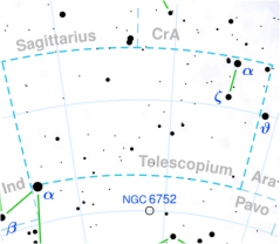Astronomy:HD 177406
| Observation data Epoch J2000.0 Equinox (celestial coordinates) | |
|---|---|
| Constellation | Telescopium |
| Right ascension | 19h 06m 55.60698s[1] |
| Declination | −48° 17′ 56.9195″[1] |
| Apparent magnitude (V) | 5.95±0.01[2] |
| Characteristics | |
| Evolutionary stage | main sequence star[1] |
| Spectral type | A0 V[3] |
| U−B color index | −0.02[4] |
| B−V color index | −0.01[4] |
| Astrometry | |
| Radial velocity (Rv) | −6.2±1.6[5] km/s |
| Proper motion (μ) | RA: +13.500[1] mas/yr Dec.: −12.738[1] mas/yr |
| Parallax (π) | 8.8414 ± 0.0541[1] mas |
| Distance | 369 ± 2 ly (113.1 ± 0.7 pc) |
| Absolute magnitude (MV) | +0.60[6] |
| Details | |
| Mass | 2.64+0.43−0.28[7] M☉ |
| Radius | 2.55±0.13[8] R☉ |
| Luminosity | 62.4+1.5−1.4[1] L☉ |
| Surface gravity (log g) | 4.00[9] cgs |
| Temperature | 10,275+229−194[7] K |
| Metallicity [Fe/H] | 0.00[10] dex |
| Rotation | 27.2 d[11] |
| Rotational velocity (v sin i) | 50 - 100[12] km/s |
| Age | 286±9[13][10] Myr |
| Other designations | |
| Database references | |
| SIMBAD | data |
HD 177406, also known as HR 7223 or rarely 47 G. Telescopii, is a solitary star[15] located in the southern constellation Telescopium. It is faintly visible to the naked eye as a white-hued point of light with an apparent magnitude of 5.95.[2] Gaia DR3 parallax measurements imply a distance of 369 light years[1] and it is currently approaching the Solar System with a heliocentric radial velocity of −6.2 km/s.[5] At its current distance, HD 177406's brightness is diminished by 0.23 magnitudes due to interstellar dust[16] and it has an absolute magnitude of +0.60.[6]
HD 177406 has a stellar classification of A0 V,[3] indicating that it is an ordinary A-type main-sequence star that is generating energy via hydrogen fusion at its core. It has 2.64 times the mass of the Sun[7] and a radius 2.55 times that of the Sun.[8] It radiates 62.4 times the luminosity of the Sun[1] from its photosphere at an effective temperature of 10,275 K.[7] It has a solar metallicity at [Fe/H] = +0.00 and it is estimated to be 286 million years old,[13] having completed 58.66% of its main sequence lifetime.[1]
References
- ↑ Jump up to: 1.0 1.1 1.2 1.3 1.4 1.5 1.6 1.7 1.8 Vallenari, A. et al. (2022). "Gaia Data Release 3. Summary of the content and survey properties". Astronomy & Astrophysics. doi:10.1051/0004-6361/202243940 Gaia DR3 record for this source at VizieR.
- ↑ Jump up to: 2.0 2.1 Høg, E.; Fabricius, C.; Makarov, V. V.; Urban, S.; Corbin, T.; Wycoff, G.; Bastian, U.; Schwekendiek, P. et al. (March 2000). "The Tycho-2 catalogue of the 2.5 million brightest stars". Astronomy and Astrophysics 355: L27–L30. ISSN 0004-6361. Bibcode: 2000A&A...355L..27H.
- ↑ Jump up to: 3.0 3.1 Houk, Nancy (1978). Michigan catalogue of two-dimensional spectral types for the HD stars: Declinations −53° to −40°. 2. Bibcode: 1978mcts.book.....H.
- ↑ Jump up to: 4.0 4.1 Alexander, J. B. (1972). "UBV observations of the RR Lyrae variable HD 176387 (MT Telescopii).". Royal Greenwich Observatory Bulletins 174: 107. Bibcode: 1972RGOB..174..107A.
- ↑ Jump up to: 5.0 5.1 Gontcharov, G. A. (November 2006). "Pulkovo Compilation of Radial Velocities for 35,495 Hipparcos stars in a common system". Astronomy Letters 32 (11): 759–771. doi:10.1134/S1063773706110065. ISSN 1063-7737. Bibcode: 2006AstL...32..759G.
- ↑ Jump up to: 6.0 6.1 Anderson, E.; Francis, Ch. (May 2012). "XHIP: An extended hipparcos compilation". Astronomy Letters 38 (5): 331–346. doi:10.1134/S1063773712050015. ISSN 1063-7737. Bibcode: 2012AstL...38..331A.
- ↑ Jump up to: 7.0 7.1 7.2 7.3 Stassun, Keivan G. et al. (9 September 2019). "The Revised TESS Input Catalog and Candidate Target List". The Astronomical Journal 158 (4): 138. doi:10.3847/1538-3881/ab3467. Bibcode: 2019AJ....158..138S.
- ↑ Jump up to: 8.0 8.1 Kervella, P.; Thévenin, F.; Di Folco, E.; Ségransan, D. (October 2004). "The angular sizes of dwarf stars and subgiants. Surface brightness relations calibrated by interferometry". Astronomy & Astrophysics 426 (1): 297–307. doi:10.1051/0004-6361:20035930. ISSN 0004-6361. Bibcode: 2004A&A...426..297K.
- ↑ Anders, F. et al. (August 2019). "Photo-astrometric distances, extinctions, and astrophysical parameters for Gaia DR2 stars brighter than G = 18". Astronomy & Astrophysics 628: A94. doi:10.1051/0004-6361/201935765. ISSN 0004-6361. Bibcode: 2019A&A...628A..94A.
- ↑ Jump up to: 10.0 10.1 Gontcharov, G. A. (December 2012). "Dependence of kinematics on the age of stars in the solar neighborhood". Astronomy Letters 38 (12): 771–782. doi:10.1134/S1063773712120031. ISSN 1063-7737. Bibcode: 2012AstL...38..771G.
- ↑ Oelkers, Ryan J.; Rodriguez, Joseph E.; Stassun, Keivan G.; Pepper, Joshua; Somers, Garrett; Kafka, Stella; Stevens, Daniel J.; Beatty, Thomas G. et al. (2018). "Variability Properties of Four Million Sources in the TESS Input Catalog Observed with the Kilodegree Extremely Little Telescope Survey". The Astronomical Journal 155 (1): 39. doi:10.3847/1538-3881/aa9bf4. Bibcode: 2018AJ....155...39O.
- ↑ Andersen, J.; Nordstrom, B. (1983). "Radial velocities of bright southern stars. I - 139 B-type HR and FK stars". Astronomy and Astrophysics Supplement Series 52: 471–482. Bibcode: 1983A&AS...52..471A.
- ↑ Jump up to: 13.0 13.1 Gontcharov, G. A. (November 2012). "Spatial distribution and kinematics of OB stars". Astronomy Letters 38 (11): 694–706. doi:10.1134/S1063773712110035. ISSN 1063-7737. Bibcode: 2012AstL...38..694G.
- ↑ "HD 177406". SIMBAD. Centre de données astronomiques de Strasbourg. http://simbad.u-strasbg.fr/simbad/sim-basic?Ident=HD+177406.
- ↑ Eggleton, P. P.; Tokovinin, A. A. (11 September 2008). "A catalogue of multiplicity among bright stellar systems". Monthly Notices of the Royal Astronomical Society 389 (2): 869–879. doi:10.1111/j.1365-2966.2008.13596.x. ISSN 0035-8711. Bibcode: 2008MNRAS.389..869E.
- ↑ Gontcharov, George A.; Mosenkov, Aleksandr V. (28 September 2017). "Verifying reddening and extinction for Gaia DR1 TGAS main sequence stars". Monthly Notices of the Royal Astronomical Society 472 (4): 3805–3820. doi:10.1093/mnras/stx2219. ISSN 0035-8711. Bibcode: 2017MNRAS.472.3805G.
<ref> tag with name "Gould1879" defined in <references> is not used in prior text.
 |


